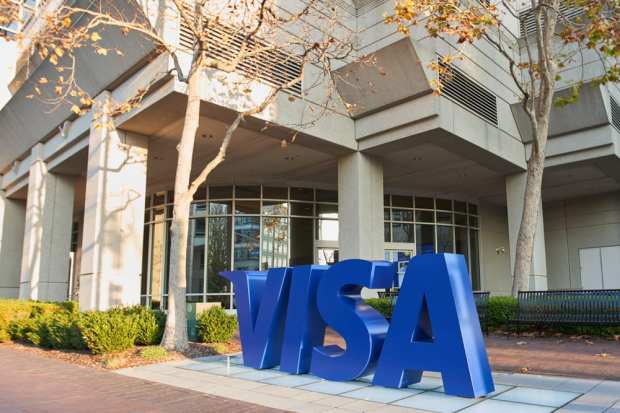Visa Beats Street On 11 Pct Payments Volume Growth

Factors such as the government shutdown, Brexit and a trade war all weighed a bit on Visa’s latest results, but Visa still managed to put up numbers that showed traction in debit transactions, up double digits. In the meantime, management noted that eCommerce growth remains robust and B2B remains a key strategic focus moving forward.
Visa beat expectations on double-digit payment volume growth even as international transactions slowed markedly. Management took note of macro-economic factors that are still uncertain in terms of their impact on consumer spending, ranging from Brexit to continued showdowns on Capitol Hill — but thus far headed into a new fiscal year underlying trends remain strong as credit and debit spending grew, measured year over year.
Processed Transactions – And Other Metrics – Up Double Digits
Overall, processed transactions stood at roughly 33.9 million in the period that ended in December — 11 percent higher than a year ago. As measured in dollars, payments volume neared $2.3 trillion, with 11 percent growth year over year, and where credit was $1.2 trillion of that tally, up 9 percent, and debit, the remainder, up 13 percent. Breaking that down a bit, U.S. credit transactions came in at $498 billion, and $446 billion for debit.
Total cards were up 4 percent across the company’s portfolio, to 3.3 billion at the end of the December period.
The above metrics helped lead to net revenues reported of $5.5 billion, above the Street at $5.4 billion, and earnings per share of $1.30 was handily above the Street at $1.25.
The push toward using cards to pay continued to buoy results, though CEO Alfred Kelly told analysts on the post-earnings conference call that the aforementioned macro concerns are having at least “some impact” on consumer spending. And, he noted, another government shutdown, were it to happen, would hit consumer spending and sentiment. Thus it remains “critical” that a deal get done on the Hill, he said.
Holiday spending during the quarter, said Kelly, was “relatively strong.” Within the U.S., according to commentary, spending on goods like fuel was lower (reflecting lower fuel prices) and spending on travel and home improvement activity decelerated. Through the 21st of January, said management, processed transactions saw a growth rate of 12 percent, and cross-border transactions were up an adjusted 6 percent.
Beyond the overall trends of credit and debit spending growth, cross-border volume growth was 7 percent, in part impacted by macro developments and in part reflecting a revenue recognition change that recognized at least some payment flows and transactions as being domestic rather than cross-border, which management stated on the call did not have significant revenue impact. Cross-border payment growth rates were also impacted by past periods that had seen activity tied to cryptocurrencies. Inbound spend that crossed borders into the United States was lower due to the dollar’s strength, but overall were termed by Kelly to be “robust.”
Supplemental materials provided by the company showed that branded volume and transactions — which carry Visa, Visa Electron, V PAY and Interlink brands — were up more than 8 percent in Canada, in Central Europe and the Middle East and more than 9 percent in the United States (as measured in constant dollars).
Contactless Continues To Be In Crosshairs
CEO Kelly and CFO Vasant Prabhu took note of new partnerships, and Kelly singled out deals spanning Canada (with Air Canada) Mexico (with Costco), India (with Amazon) and Australia.
Key among new growth opportunities is the area of contactless payments. Tap-to-pay transactions, management stated on the post-release conference call, showed 2 points of growth measured sequentially quarter over quarter and 8 points of growth year over year. Excluding the United States, said the executives, 44 percent of transactions that are done face to face have utilized tap-and-pay functionality. Kelly pointed on the call to recent pacts with JPMorgan Chase that will offer cards that in turn have contactless payment ability, and he said, too, that Wells Fargo and Bank of America will also bring tap-to-pay cards out.
Visa Direct volume, said management, was up more than 100 percent in terms of transaction count, and real-time funds delivery is gaining traction, and has found uptake by businesses.
B2B
Questions on the earnings call focused in part on B2B initiatives, and Kelly noted that the company over the course of the last several months has started to run its efforts here with the mentality that it is a separate business unit within the firm. And, with a nod toward the build vs. buy debate, he mentioned the recent developments in the space — notably of course the acquisition of cross-border payment firm Earthport, based in the U.K., which helps banks and enterprises complete international payments. As has been widely reported, Mastercard topped Visa’s $250 million December bid for the firm by about 10 percent and the U.K. company’s management has embraced the bid.
Said Kelly in respect to that transaction, “we’re considering our options.”
Looking Ahead
It’s too early to conclude yet, said management, whether a change in the outlook is called for, and Visa has reaffirmed its guidance for the year, even with the macro factors noted at the top of this story. The revenue growth rate forecast remains in the low double digits on a nominal basis, and earnings per share growth on a mid-teens non-GAAP basis.
